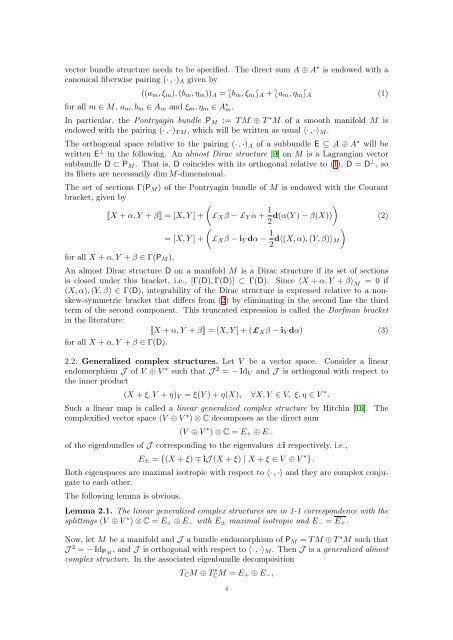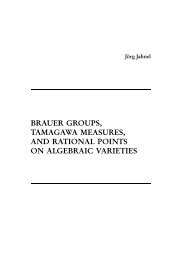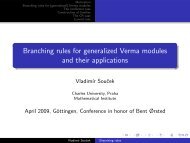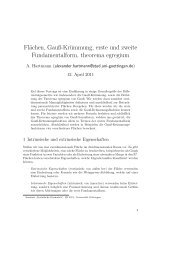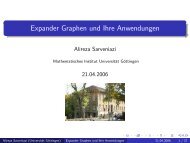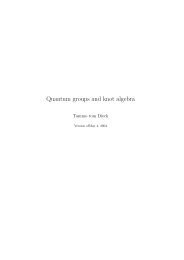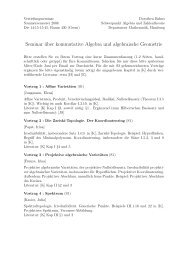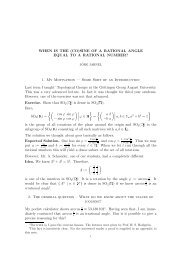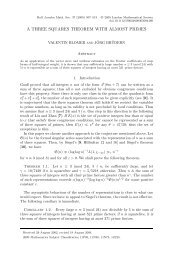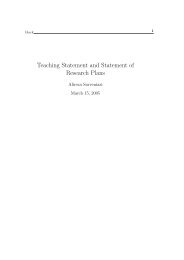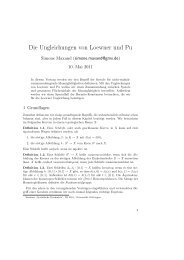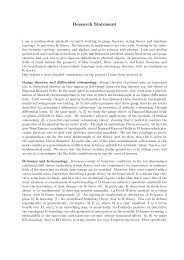Glanon groupoids - Mathematisches Institut - GWDG
Glanon groupoids - Mathematisches Institut - GWDG
Glanon groupoids - Mathematisches Institut - GWDG
Create successful ePaper yourself
Turn your PDF publications into a flip-book with our unique Google optimized e-Paper software.
vector bundle structure needs to be specified. The direct sum A ⊕ A ∗ is endowed with a<br />
canonical fiberwise pairing (· , ·) A given by<br />
((a m , ξ m ), (b m , η m )) A = ⟅b m , ξ m ⟆ A + ⟅a m , η m ⟆ A (1)<br />
for all m ∈ M, a m , b m ∈ A m and ξ m , η m ∈ A ∗ m.<br />
In particular, the Pontryagin bundle P M := T M ⊕ T ∗ M of a smooth manifold M is<br />
endowed with the pairing (· , ·) T M , which will be written as usual 〈· , ·〉 M .<br />
The orthogonal space relative to the pairing (· , ·) A of a subbundle E ⊆ A ⊕ A ∗ will be<br />
written E ⊥ in the following. An almost Dirac structure [9] on M is a Lagrangian vector<br />
subbundle D ⊂ P M . That is, D coincides with its orthogonal relative to (1), D = D ⊥ , so<br />
its fibers are necessarily dim M-dimensional.<br />
The set of sections Γ(P M ) of the Pontryagin bundle of M is endowed with the Courant<br />
bracket, given by<br />
X + α, Y + β = [X, Y ] +<br />
(£ X β − £ Y α + 1 )<br />
2 d(α(Y ) − β(X)) (2)<br />
(<br />
= [X, Y ] + £ X β − i Y dα − 1 )<br />
2 d〈(X, α), (Y, β)〉 M<br />
for all X + α, Y + β ∈ Γ(P M ).<br />
An almost Dirac structure D on a manifold M is a Dirac structure if its set of sections<br />
is closed under this bracket, i.e., [Γ(D), Γ(D)] ⊂ Γ(D). Since 〈X + α, Y + β〉 M<br />
= 0 if<br />
(X, α), (Y, β) ∈ Γ(D), integrability of the Dirac structure is expressed relative to a nonskew-symmetric<br />
bracket that differs from (2) by eliminating in the second line the third<br />
term of the second component. This truncated expression is called the Dorfman bracket<br />
in the literature:<br />
X + α, Y + β = [X, Y ] + (£ X β − i Y dα) (3)<br />
for all X + α, Y + β ∈ Γ(D).<br />
2.2. Generalized complex structures. Let V be a vector space. Consider a linear<br />
endomorphism J of V ⊕ V ∗ such that J 2 = − Id V and J is orthogonal with respect to<br />
the inner product<br />
(X + ξ, Y + η) V = ξ(Y ) + η(X), ∀X, Y ∈ V, ξ, η ∈ V ∗ .<br />
Such a linear map is called a linear generalized complex structure by Hitchin [16]. The<br />
complexified vector space (V ⊕ V ∗ ) ⊗ C decomposes as the direct sum<br />
(V ⊕ V ∗ ) ⊗ C = E + ⊕ E −<br />
of the eigenbundles of J corresponding to the eigenvalues ±i respectively, i.e.,<br />
E ± = {(X + ξ) ∓ iJ (X + ξ) | X + ξ ∈ V ⊕ V ∗ } .<br />
Both eigenspaces are maximal isotropic with respect to 〈· , ·〉 and they are complex conjugate<br />
to each other.<br />
The following lemma is obvious.<br />
Lemma 2.1. The linear generalized complex structures are in 1-1 correspondence with the<br />
splittings (V ⊕ V ∗ ) ⊗ C = E + ⊕ E − with E ± maximal isotropic and E − = E + .<br />
Now, let M be a manifold and J a bundle endomorphism of P M = T M ⊕ T ∗ M such that<br />
J 2 = − Id PM , and J is orthogonal with respect to 〈· , ·〉 M . Then J is a generalized almost<br />
complex structure. In the associated eigenbundle decomposition<br />
T C M ⊕ T ∗ C M = E + ⊕ E − ,<br />
4


